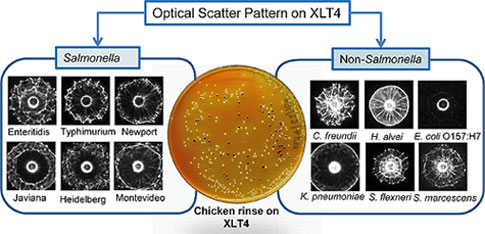A new laser sensor can identify salmonella bacteria in food samples as much as three times faster than conventional detection methods.
Developed by researchers at Purdue University, the sensor, called BARDOT (bacterial rapid detection using optical scatter technology), scans bacteria colonies and generates a distinct black-and-white “fingerprint” to identify the bacteria in less than 24 hours. Traditional methods can take 72 hours and often require artificial alteration of the colonies.

Salmonella detection can be made easier thanks to a newly developed laser sensor. Courtesy of Purdue University.
BARDOT uses a red diode laser to scan the bacteria colonies on an agar plate, said researcher Arun Bhunia, a professor of food science who collaborated with then Purdue researcher Daniel Hirleman to create the sensor, which is about the size of a small microwave oven.
When the light penetrates a bacteria colony, it produces a scatter pattern, which is then matched against a library of images to identify the type of bacteria.
In their study, the researchers grew bacteria from rinses of contaminated chicken, spinach and peanut butter on agar plates for about 16 hours. They scanned the colonies and found that BARDOT can identify salmonella with 95.9 percent accuracy. It also individually distinguished eight of the most prevalent salmonella variations, which can help identify the original source of contamination.
“[BARDOT] is so versatile, it can find organisms that you didn’t even think about,” Bhunia said.
While other such tools can detect only one kind of bacteria, BARDOT picks out multiple types with a single scan. Besides salmonella, it can identify foodborne pathogens including E. coli, Vibrio, Listeria and Bacillus.
The research was funded by the U.S. Department of Agriculture, the National Institute of Allergy and Infectious Diseases, and the Purdue Center for Food Safety Engineering.
The work was published in mBio.
For more information, visit www.purdue.edu.